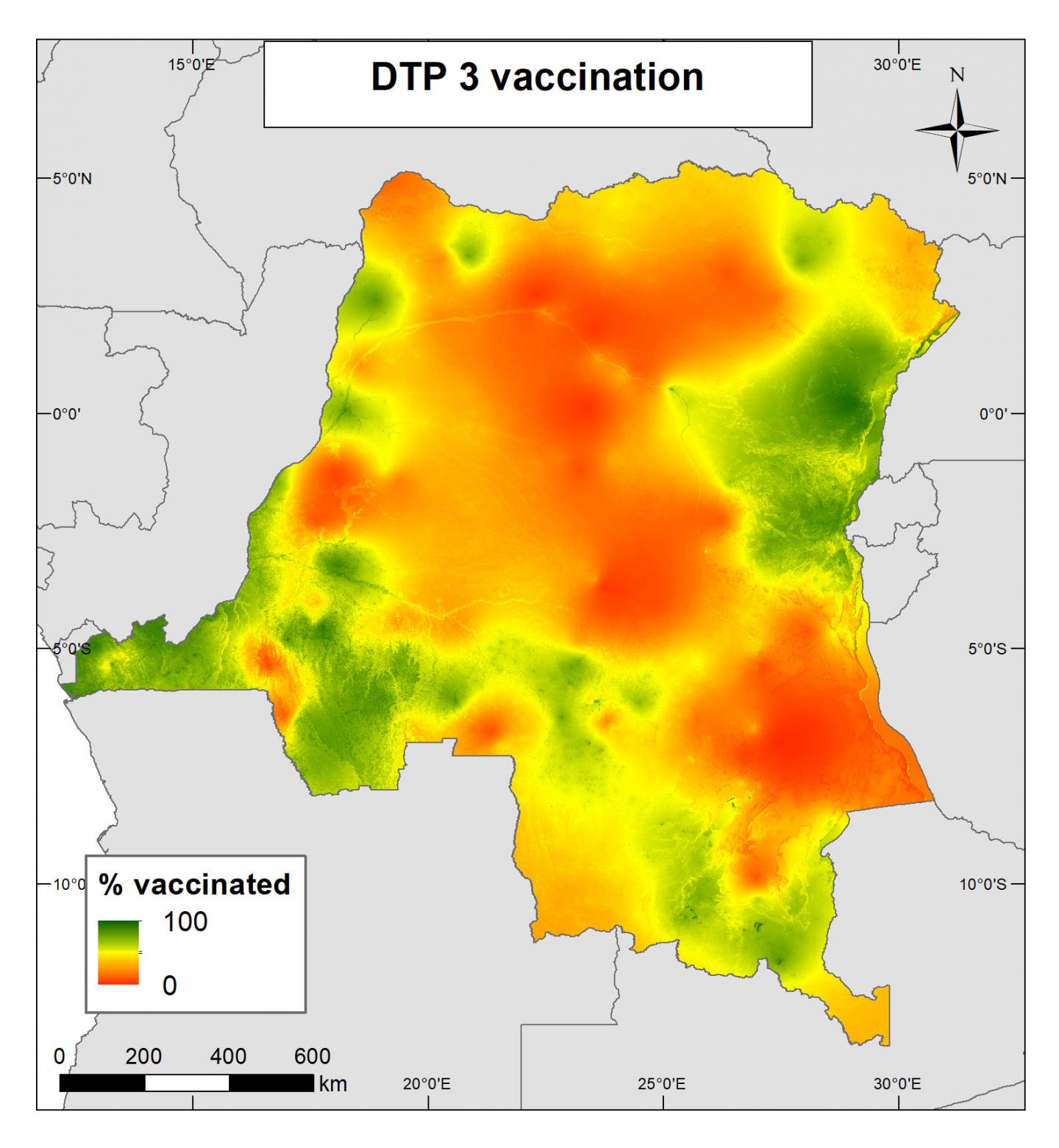
Credit: WorldPop
A study by the University of Southampton shows that several low-and middle-income countries, especially in Africa, need more effective child vaccination strategies to eliminate the threat from vaccine-preventable diseases.
Geographers from the University’s WorldPop group found diphtheria, tetanus and whooping cough (pertussis) vaccination levels in Nigeria, Democratic Republic of the Congo (DRC), Ethiopia, Mozambique and also in Cambodia, southeast Asia, fall short of the 80 per cent threshold recommended by the World Health Organization (WHO). This means the potential for disease circulation and outbreak in these countries remains high.
Findings are published in the journal Nature Communications.
Using data from Demographic and Health Surveys (DHS) conducted between 2011 and 2016, the researchers examined the performance of routine immunisation (RI) through the delivery of the three doses of diphtheria-tetanus-pertussis (DTP1-3) to children aged five and under, including drop-out rates between doses. They compared this with the delivery of the measles-containing vaccine (MCV), for which additional supplementary immunisation activities (SIAs) are often undertaken. Highly detailed (one km sq.) maps showing levels of vaccine coverage for each country and reflecting the relative performance of routine and supplementary activities were produced.
The maps indicate substantial gaps in the delivery of the first dose of the DTP vaccine, particularly in DRC, Nigeria and Ethiopia – suggesting poor access to routine immunisation. However, where routine delivery of the measles vaccine in the same countries was supported with recurrent SIA campaigns, rates of coverage were substantially higher. In contrast, Mozambique and Cambodia had fewer campaigns and saw no real improvement – although both countries had stronger routine delivery systems.
These results suggest that additional targeted campaigns can make a big difference to immunisation service delivery, especially in areas with poor routine immunisation coverage. Lead researcher Dr Chigozie Edson Utazi comments: “Many things can lead to low vaccination levels, such as poor access to health services, poor education, low stocks of vaccines and even vaccine refusal. We have shown that supplementary activities, as a short-term approach, can help address some of these problems, boost immunisation and improve disease resistance.
“The success of any vaccine delivery strategy lies not only with a good geographical spread, but also in ensuring coverage level among the population is high enough to stop the spread of the disease. We hope our fine spatial scale and regional maps will help countries to understand in greater detail where coverage is low and decide what further interventions are needed in specific areas to work towards disease elimination.”
The researchers now hope to build on their work by extending to other countries and conducting further studies which incorporate data on treatment-seeking behaviour, travel time to health facilities and mobile phone network coverage. It is hoped that this could lead to the design and implementation of tailored vaccination delivery programmes.
The study, supported by the Bill and Melinda Gates Foundation, also involved scientists from PennState University, Princeton University, Johns Hopkins Bloomberg School of Public Health and London School of Hygiene and Tropical Medicine.
###
Notes to Editors
1) The paper Mapping vaccination coverage to explore the effects of delivery mechanisms and inform vaccination strategies is published in the journal Nature Communications and can be found here: https:/
2) For further information on interviews contact Peter Franklin, Media Relations, University of Southampton. Tel ++44 23 8059 3212 Email: [email protected]
3) For more information about WorldPop visit: https:/
4) More on Geography and Environmental Science at the University of Southampton can be found at: https:/
5) The University of Southampton drives original thinking, turns knowledge into action and impact, and creates solutions to the world’s challenges. We are among the top 100 institutions globally (QS World University Rankings 2019). Our academics are leaders in their fields, forging links with high-profile international businesses and organisations, and inspiring a 24,000-strong community of exceptional students, from over 135 countries worldwide. Through our high-quality education, the University helps students on a journey of discovery to realise their potential and join our global network of over 200,000 alumni. http://www.
6) The study is supported by the Bill & Melinda Gates Foundation (C.J.E.M., M.J.F., A.J.T., J.L.) through grant number: OPP1094793. A.J.T. is supported by funding from NIH/NIAID (U19AI089674), the Bill & Melinda Gates Foundation (OPP1106427, 1032350, OPP1134076), the Clinton Health Access Initiative, National Institutes of Health and a Wellcome Trust Sustaining Health Grant (106866/Z/15/Z).
Media Contact
Peter Franklin
[email protected]
Related Journal Article
http://dx.




